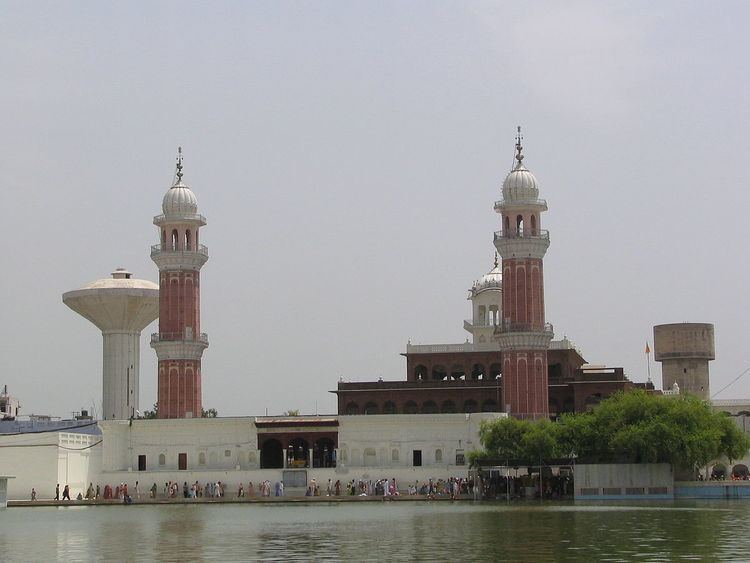 | ||
Address Atta Mandi, Katra Ahluwalia, Amritsar, Punjab 143006 | ||
Ramgarhia bunga
Ramgarhia Bunga (Bunga means "mansion"), is a three-storeyed marvel of Sikh architecture located in the vicinity of Shri Darbar Sahib Amritsar. Ramgarhia bunga, a pre-Ranjit Singh structure was built by Sikh warrior and Ramgarhia misl chief Jassa Singh Ramgarhia in 1755 is the only surviving example of Bunga architecture typology. It was constructed to fortifying the area to protect the holy complex from outside invasion.
Contents
Bunga structure
Ramgarhia Bunga consists of three flat-roofed ranges, each of two principal storeys, arranged round three sides of a courtyard and is constructed almost of small burnt bricks (Nanakshahi) set in lime and mud mortar. The colonnade and the triple arches are of red sandstone. The undersides of the vaults and all the walls were finished internally and externally with lime plaster and lime wash, much of it decorative with arches. Lower levels are approached by two flights of steps, one from outside and the other from within the courtyard.
History
During the reign of the Muslim Mughal Emperors, The Golden Temple was damaged many times, but each time it was rebuilt by the Sikhs. Sardars of the 12 Misls decided that some of the Khalsa leaders must be housed inside it for its protection against their enemies. Sardar Jassa Singh Ramgarhia had conquered territory as far afield as Delhi, where he removed the slab from the throne on which the Mughal coronation ceremonies were held. He brought the slab to Amritsar and placed it in the Ramgarhia Bunga where it still lies.
Renovation
The original domes on the minarets were damaged and then removed in 1903 because of an earthquake. The minarets were again damaged during Operation Blue Star in 1984, but later renovated by the Shiromani Gurdwara Parbandhak Committee and the Ramgarhia Society Sardar Jassa Singh Ramgarhia Federation. Later, some Babas of Kar Sewawale had done colossal damage to the heritage site by converting a portion into their abode.
The works being undertaken would focus on curtailing the use of water and prevent its ingress into the fabric of the structure. Infills would be removed and terracing of the roof re-done in traditional materials with appropriate drainage. Temporary structures shall be dismantled and ventilation of hitherto enclosed spaces shall be improved. Cement plaster shall be removed from the walls wherever used shall be replaced with lime plaster. Removal of new brick-cement flooring of the courtyard will help relieving a lot of superimposed load on the vaulted structure below. Major structural cracks shall be stapled by helical bars and grouted. Lesser vertical cracks in the brick masonry wall will be stitched using thin bricks, similar to the original, and lime mortar. Blocked openings between rooms will be opened to provide for proper cross-ventilation and facilitate drying up process. The cement concrete flooring of all rooms will be dismantled. Photo documentation would be carried out at all stages before, during and after conservation. The adaptive re-use of the building would subsequently be carefully considered so that the structure is appropriately used as a public place.
